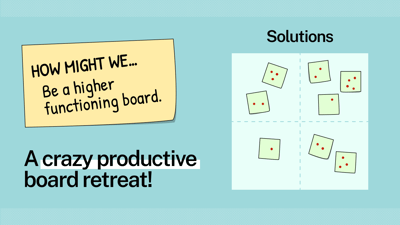Unleash Your Project Management Mojo

When a nonprofit is planned and then founded, entrepreneurial energy carries the day.
Barely baked, it’s small enough to operate with informal communication, and those involved wear enough hats to get everything done.
But then a measure of achievement happens, fueling growth of staff and services and the number of clients and other goings-on.
More programs are developed that require new hires, unique skills, and additional facility space. And along the way, fundraising is a concurrent, ever-present need for keeping the doors open.
Before you know it, things start falling through the cracks — unless there’s a good system in place to prevent it.
Say hello to Project Management
Project management involves processes, components, methods, skills, and knowledge to achieve specific objectives.
From programs to fundraising to training and beyond, project management is a not-so-secret weapon for success. Simply put, by embracing it, things are not left to chance.
Roles and responsibilities are spelled out
This is especially important as any organization gets bigger and capacity swells.
Not only does project management clarify everyone’s function, it makes it seamless for new hires and old hands to know how things get done.
That means no one should ever wonder about (a) how their job fits within the system, (b) what is expected of them, and (c) the process they should follow for delivering their workload.
You can find out what's not working
We subconsciously cringe when we hear, “Because this is how it’s always been done.”
Inherited, outdated processes that gum up the works are a waste of valuable time and resources and make it difficult for teammates to provide constructive input.
Conversely, true project management includes managers creating space for their direct reports to note what is or isn’t working in their workload. Obvious improvements should then be made quickly with little bureaucratic delay.
Moreover, once identified, project problems can be tracked to ensure they’re taken care of and neither forgotten nor repeated.
Project Management provides organizational opportunities
Although working remotely was not a new concept, the Pandemic transformed working from home from fringe to mainstream almost overnight.
Coworkers couldn’t just drop into someone’s office or cubicle, managers lost the benefit of onsite supervision, documents couldn’t be tossed onto another’s desk, and in-person meetings were impossible.
As such, the ever-changing world of remote work demanded new ways to conduct internal business. Essentially, it created room to innovate for improving workstreams.
In fact, there’s always room for innovation when it comes to project management. It should be a dynamic process that keeps up with the needs of the organization.
Project Management — a recipe for success
From new client programs to fundraising campaigns to training new hires, project management keeps things running smoothly from start to finish.
Good project management, that is. At CauseMic, we like to say, “Go slow to move fast.” By that, we mean taking the time to create a system and processes that ensure complete alignment, with input from entry level to top management.
So instead of reinventing the wheel when a new project arises, you can hit the ground running with a clear vision of how to get things done.
You’ll be more efficient while avoiding single points of failure (meaning, no step in the project gets overlooked or under-resourced).
Think of it like a recipe for, say, chocolate chip cookies.
The process is defined, each component is known, all steps are listed in order, and the final deliverable (two dozen yummy cookies) is completed within a specific time frame.
But baking without a recipe is a gamble. If just one ingredient is wrong or a step forgotten, what would have been a delicious treat is instead your latest compost toss.
It’s not over just because it’s done – Enter the “Retro”
So you’ve wrapped up a fundraising campaign or another sizable project. Go ahead and celebrate its completion — but then, relive it in detail!
For us, this project retrospective (we call it a “retro,”, others have referred to this as a “post mortem”) is a pillar of project management. It’s crucial to understand what happened in every phase, good or bad or in-between.
So we review the project to know things like:
- What went well?
- What didn’t go well?
- What could we do better?
Hardly an exhaustive list, these are basic questions to get the ball rolling with each person involved. Everyone will likely have valid input, so make room for frank discussions that can help the next project run even smoother.
One important aspect is whether appropriate space was devoted to collaboration.
This can be particularly thorny with projects involving creative development. When copy, design, and production are siloed, opportunities for turning out the best possible pieces can be lost.
There's more where that came from
Your team is rock-solid, and finally all of your projects are running perfectly. Nonetheless, it’s not quite time to put things on cruise control.
Does everyone know what they’ll be doing during the next quarter? Have you scoped projects throughout the upcoming year?
Thinking about your current fundraising projects, are you going to churn out the same stuff next year? Nonprofits that fall into this rut lose the benefit of testing new approaches, of optimizing campaigns to grow their audience and supporter base.
Moreover, by projecting ahead, you can identify gaps in your team’s skills and determine the need for additional capacity.
As such, this could be an excellent time to offer professional development opportunities to your existing team.
Big or small, new or established, every nonprofit can find organizational success with project management. Just take it one step at a time!
For more about this or how to double your revenue within three years, 



